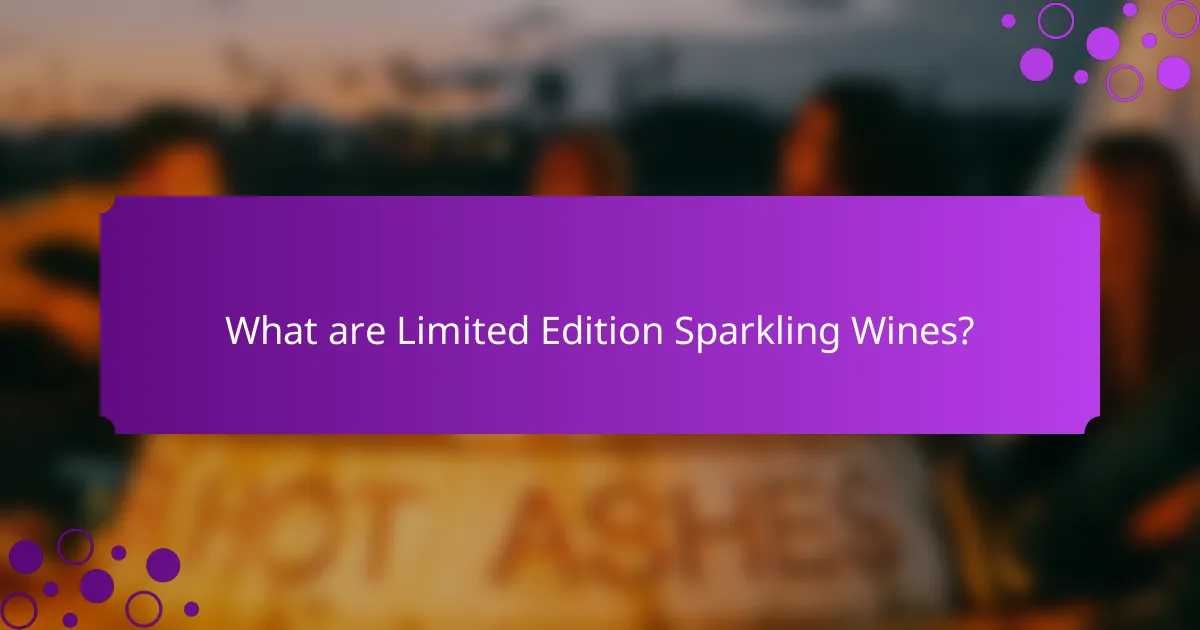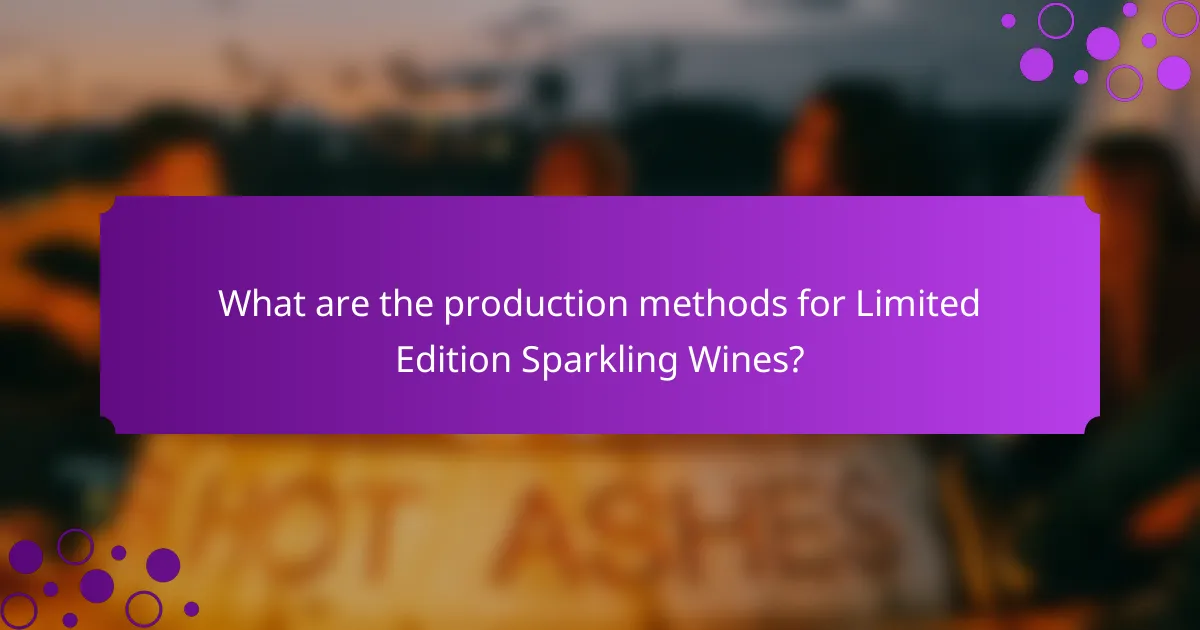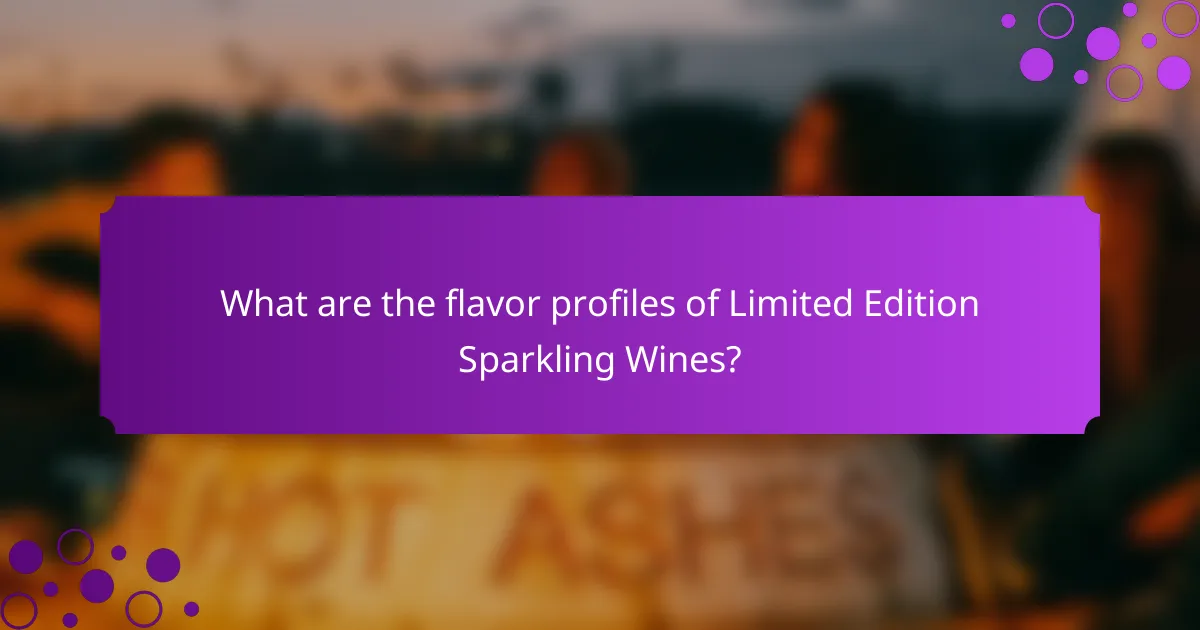
What are Limited Edition Sparkling Wines?
Limited Edition Sparkling Wines are unique sparkling wines produced in small quantities. These wines often feature distinctive flavors, production methods, or packaging. They are typically created to celebrate special occasions or events. Limited editions can be crafted from specific grape varieties or regions. The exclusivity often enhances their appeal among collectors and enthusiasts. For instance, a winery might release a limited edition to mark an anniversary or a harvest. The production of these wines may involve traditional methods, such as méthode champenoise. This process can lead to unique flavor profiles that differ from standard offerings.
How are Limited Edition Sparkling Wines defined?
Limited Edition Sparkling Wines are defined as unique sparkling wines produced in limited quantities. These wines often showcase distinctive characteristics that set them apart from regular offerings. Limited editions may feature special blends, unique aging processes, or rare grape varieties. They are typically released to commemorate specific events or milestones. The production is often restricted to enhance exclusivity. Collectors and enthusiasts highly value these wines for their rarity and uniqueness. For example, a winery may produce a limited edition sparkling wine to celebrate an anniversary, resulting in a specific vintage that is sought after by connoisseurs.
What differentiates Limited Edition Sparkling Wines from regular sparkling wines?
Limited Edition Sparkling Wines differ from regular sparkling wines primarily in their production methods and exclusivity. Limited editions often use unique grape varieties or specific vineyard locations. They may undergo distinct fermentation processes or aging techniques that are not typical for regular sparkling wines. This results in unique flavor profiles and aromas. Additionally, limited editions are produced in smaller quantities, enhancing their rarity and appeal. Regular sparkling wines are generally mass-produced with standardized methods. The limited nature of these wines often leads to higher price points and collectible status.
What attributes make a sparkling wine ‘limited edition’?
A sparkling wine is considered ‘limited edition’ due to its restricted production quantity. This exclusivity often results from unique vineyard selections or specific vintage years. Limited editions may also feature special aging processes or distinct grape blends. Packaging can differentiate these wines, often including unique labels or bottles. Additionally, they may be released during special occasions or anniversaries. These attributes enhance the wine’s desirability among collectors and enthusiasts. Limited edition sparkling wines often command higher prices due to their rarity.
Why are Limited Edition Sparkling Wines sought after?
Limited Edition Sparkling Wines are sought after due to their exclusivity and unique characteristics. These wines often feature distinct flavor profiles and production methods that set them apart from standard offerings. Limited editions are typically produced in smaller quantities, enhancing their desirability among collectors and enthusiasts. The rarity creates a sense of urgency, prompting consumers to purchase before they sell out. Additionally, many limited editions are crafted by renowned wineries, adding prestige to the experience. The unique attributes may include special aging processes or the use of rare grape varieties. Historical significance or special occasions often accompany these releases, further elevating their appeal. Collectors often view them as investments, anticipating future value appreciation.
What value do collectors find in Limited Edition Sparkling Wines?
Collectors find significant value in Limited Edition Sparkling Wines due to their rarity and potential for appreciation. Limited editions often feature unique production methods, enhancing their desirability. These wines may come from prestigious vineyards, adding to their allure. Additionally, collectors appreciate the craftsmanship and distinct flavor profiles associated with these editions. Historical significance can also elevate a wine’s value. As demand for such wines increases, their market value can appreciate substantially over time. This combination of rarity, quality, and investment potential makes Limited Edition Sparkling Wines highly sought after by collectors.
How do Limited Edition Sparkling Wines enhance special occasions?
Limited Edition Sparkling Wines enhance special occasions by offering unique flavors and exclusive experiences. These wines are often crafted in small batches, making them rare and desirable. Their distinct characteristics can elevate celebrations, creating memorable moments. The exclusivity of limited editions often adds a sense of prestige to events. For example, a well-known winery may release a special vintage for anniversaries or holidays. This can lead to heightened appreciation among guests. The quality of these wines typically reflects meticulous production methods. Such attention to detail ensures a superior taste profile that complements festive meals.

What are the production methods for Limited Edition Sparkling Wines?
Limited Edition Sparkling Wines are produced using methods such as the Traditional Method and the Charmat Method. The Traditional Method, also known as méthode champenoise, involves a secondary fermentation in the bottle. This method creates fine bubbles and complex flavors. The Charmat Method, on the other hand, conducts secondary fermentation in a large tank. This method is quicker and often results in fresher, fruitier wines.
Both methods require specific grape varieties, typically Chardonnay, Pinot Noir, and Pinot Meunier. The grapes are harvested, pressed, and fermented to create a base wine. For the Traditional Method, the base wine undergoes a second fermentation after being bottled with sugar and yeast. In contrast, the Charmat Method combines the base wine with sugar and yeast in a pressurized tank.
Limited Edition Sparkling Wines may also incorporate unique aging techniques. Some producers age their wines on lees for extended periods to enhance flavor complexity. Others may use oak barrels for fermentation to impart additional characteristics.
These production methods ensure that Limited Edition Sparkling Wines offer distinctive flavors and quality. The choice of method influences the final taste, aroma, and bubble size, contributing to their exclusivity.
How is the traditional method used in creating these wines?
The traditional method, also known as méthode champenoise, is used to create limited edition sparkling wines. This process begins with primary fermentation, where base wine is produced. Afterward, a mixture of sugar and yeast, called liqueur de tirage, is added. The wine is then bottled and sealed, allowing secondary fermentation to occur inside the bottle. This fermentation produces carbon dioxide, creating the wine’s bubbles.
Following this, the wine undergoes aging on its lees, which enhances flavor complexity. The aging period can last from several months to years, depending on the desired profile. After aging, the bottles are riddled to collect sediment near the neck. This sediment is then removed through a process called disgorgement. Finally, a dosage of sugar and wine, known as liqueur d’expédition, is added before corking the bottle.
This method is renowned for producing high-quality sparkling wines with rich flavors and fine bubbles. The traditional method has been historically significant in regions like Champagne, France, where it originated in the 17th century.
What are the key steps in the traditional method of sparkling wine production?
The key steps in the traditional method of sparkling wine production are primary fermentation, secondary fermentation, riddling, disgorgement, and dosage. Primary fermentation involves converting grape juice into wine through yeast activity. This wine is then bottled with a mixture of sugar and yeast to initiate secondary fermentation. During secondary fermentation, carbon dioxide is produced, creating the sparkling effect. Riddling is the process of gradually tilting and rotating the bottles to collect sediment near the neck. Disgorgement removes this sediment by freezing the neck and ejecting the frozen plug. Finally, dosage adds a mixture of sugar and wine to adjust sweetness before corking. This method, known as méthode champenoise, is used for producing high-quality sparkling wines like Champagne.
How does the traditional method impact the flavor profile?
The traditional method enhances the flavor profile of sparkling wines through secondary fermentation in the bottle. This process creates complex flavors and aromas, including notes of bread, brioche, and nuts. The autolysis of yeast contributes richness and creaminess to the mouthfeel. Additionally, the extended aging on the lees adds depth and a distinctive character. Studies show that wines produced using the traditional method often exhibit a more nuanced flavor profile compared to those made through other methods. The result is a well-rounded, sophisticated taste that appeals to connoisseurs.
What alternative production methods exist for Limited Edition Sparkling Wines?
Alternative production methods for Limited Edition Sparkling Wines include the Traditional Method, Charmat Method, and Ancestral Method. The Traditional Method involves secondary fermentation in the bottle, creating natural carbonation. This method is commonly used for high-quality sparkling wines like Champagne. The Charmat Method, on the other hand, conducts secondary fermentation in a pressurized tank. This method is often used for Prosecco and results in a fresher flavor profile. The Ancestral Method, also known as Pétillant-Naturel, involves bottling the wine before fermentation is complete. This method produces a lightly sparkling wine with unique characteristics. Each method contributes distinct flavors and textures to the final product, catering to diverse consumer preferences.
How does the Charmat method differ from the traditional method?
The Charmat method differs from the traditional method primarily in the fermentation process. The Charmat method conducts secondary fermentation in a large pressurized tank. This contrasts with the traditional method, where secondary fermentation occurs in individual bottles. The Charmat method typically results in fresher and fruitier flavors. In comparison, the traditional method often develops more complex and nuanced characteristics. Additionally, the Charmat method is generally faster, taking weeks instead of months. This method is commonly used for Prosecco production, while the traditional method is associated with Champagne.
What are the benefits of using the Charmat method for Limited Edition Sparkling Wines?
The Charmat method enhances Limited Edition Sparkling Wines by promoting freshness and fruitiness. This technique involves secondary fermentation in pressurized tanks, allowing for quicker production. It results in wines with vibrant flavors and aromas, appealing to consumers seeking immediate enjoyment. The method also maintains the wine’s clarity and effervescence, contributing to a visually appealing product. Furthermore, the Charmat method is cost-effective, enabling producers to offer high-quality sparkling wines at competitive prices. This approach has gained popularity among winemakers aiming to create accessible yet premium sparkling options.

What are the flavor profiles of Limited Edition Sparkling Wines?
Limited Edition Sparkling Wines typically exhibit diverse and complex flavor profiles. These wines often showcase fruity notes, including apple, pear, and citrus. Floral aromas such as jasmine and honeysuckle are also common. Additionally, some varieties present toasty or nutty characteristics, resulting from the aging process. The sweetness levels can vary, ranging from brut to demi-sec. Terroir influences can impart unique mineral and herbal nuances. Limited editions may also feature experimental blends, enhancing their distinctiveness. Overall, these wines are crafted to deliver an exceptional tasting experience.
How do different grape varieties influence the flavor profile?
Different grape varieties significantly influence the flavor profile of wines. Each grape type has unique characteristics that affect taste, aroma, and mouthfeel. For example, Chardonnay grapes typically produce wines with notes of apple, pear, and citrus. In contrast, Pinot Noir grapes often yield flavors of cherry, raspberry, and earthy undertones. Additionally, Sauvignon Blanc is known for its zesty acidity and green fruit flavors, such as lime and green apple. The terroir, or environmental factors, also plays a role in how these flavor profiles develop. Factors like soil type, climate, and vineyard practices can enhance or alter the inherent flavors of each grape variety. These distinctions are crucial for winemakers when crafting limited edition sparkling wines, as they aim to create specific flavor experiences for consumers.
What are the most common grape varieties used in Limited Edition Sparkling Wines?
The most common grape varieties used in Limited Edition Sparkling Wines are Chardonnay, Pinot Noir, and Pinot Blanc. Chardonnay contributes acidity and elegance, making it a staple in sparkling wine production. Pinot Noir adds body and structure, enhancing the wine’s complexity. Pinot Blanc, while less common, provides a fresh and fruity profile. These varieties are often blended to create balanced and high-quality sparkling wines. The use of these grapes is supported by their historical significance in regions like Champagne, where they are integral to the traditional method of sparkling wine production.
How does terroir affect the flavor of these wines?
Terroir significantly influences the flavor of wines by incorporating environmental factors. These factors include soil composition, climate, and topography. The unique soil types contribute specific minerals and nutrients, affecting the vine’s growth and grape characteristics. Climate impacts the ripening process, which determines sugar levels and acidity. Topography influences sunlight exposure and drainage, further shaping grape development. Studies show that wines from different terroirs exhibit distinct flavor profiles, such as fruitiness or minerality. For example, Champagne’s chalky soil contributes to its signature crispness. Thus, terroir is crucial in defining the overall taste and quality of limited edition sparkling wines.
What tasting notes can be expected from Limited Edition Sparkling Wines?
Limited Edition Sparkling Wines often exhibit complex tasting notes. Common flavors include citrus, apple, and pear. These wines may also present floral notes such as jasmine or honeysuckle. Additionally, hints of brioche or toast are frequently detected due to aging on lees. Some varieties showcase stone fruit flavors, like peach or apricot. The sweetness level can range from dry to off-dry, impacting the overall profile. Each wine’s unique terroir contributes distinct mineral or earthy undertones. The aging process and production methods further enhance these tasting notes.
What are the common tasting notes found in these wines?
Common tasting notes in limited edition sparkling wines include citrus, apple, and pear. These wines often exhibit floral aromas such as jasmine and honeysuckle. Additionally, they may have notes of brioche or toast due to aging on lees. Some sparkling wines present hints of minerality and stone fruit. The presence of acidity provides a crisp finish. These characteristics are influenced by the grape varieties and production methods used. For example, Chardonnay often contributes to the fruit and floral notes, while Pinot Noir adds depth and complexity.
How do aging and production methods alter tasting notes?
Aging and production methods significantly influence the tasting notes of sparkling wines. Aging allows wines to develop complex flavors through oxidation and interaction with yeast. This process can introduce notes of toast, brioche, or nuttiness. Production methods, such as the traditional method, can enhance the texture and create fine bubbles. The fermentation process can also impart fruity or floral characteristics. For example, secondary fermentation in the bottle adds depth and richness. Research indicates that wines aged longer tend to have more nuanced flavors compared to younger wines. Thus, both aging and production methods are crucial in shaping the overall tasting experience.

What occasions are suitable for Limited Edition Sparkling Wines?
Limited edition sparkling wines are suitable for special occasions. These occasions include weddings, anniversaries, and milestone birthdays. They enhance celebrations with their unique flavors and presentation. Limited editions often feature exclusive blends or packaging. Such wines are ideal for formal events and intimate gatherings alike. They can also elevate holiday festivities and corporate celebrations. The rarity of these wines adds a sense of luxury. This makes them perfect for gifting on significant occasions.
What special events are best complemented by Limited Edition Sparkling Wines?
Limited Edition Sparkling Wines are best complemented by celebratory events such as weddings, anniversaries, and milestone birthdays. These wines add a touch of elegance and festivity to significant occasions. The effervescence of sparkling wines enhances the celebratory atmosphere. Additionally, they pair well with holiday gatherings and New Year celebrations. Their unique flavor profiles make them suitable for toasting and special moments. Many people choose limited editions for their rarity and exclusivity. This choice elevates the experience for guests and hosts alike.
How can Limited Edition Sparkling Wines enhance celebrations like weddings or anniversaries?
Limited Edition Sparkling Wines enhance celebrations like weddings or anniversaries by offering unique flavors and memorable experiences. These wines often feature exclusive blends and limited production runs. This exclusivity adds a special touch to significant events. The unique flavors can elevate the overall dining experience during celebrations. Additionally, serving a limited edition wine can serve as a conversation starter among guests. It creates a sense of luxury and sophistication. Sparkling wines are also traditionally associated with celebrations, making them a fitting choice. Their effervescence symbolizes joy and festivity, enhancing the celebratory atmosphere.
What role do these wines play in corporate gifting or events?
Limited edition sparkling wines serve as sophisticated gifts in corporate settings. They convey appreciation and enhance professional relationships. The unique character of these wines makes them memorable choices for events. Their exclusivity often impresses clients and partners. According to a study, 70% of recipients feel valued when receiving quality wines as gifts. These wines also elevate the atmosphere at corporate events, adding a touch of elegance. Their diverse flavor profiles can cater to various tastes, making them versatile for different occasions. Overall, they play a significant role in fostering goodwill and creating lasting impressions in corporate environments.
What tips should be considered when selecting Limited Edition Sparkling Wines?
When selecting Limited Edition Sparkling Wines, consider the wine’s production method. Traditional methods, such as méthode champenoise, enhance complexity. Evaluate the flavor profile, focusing on sweetness levels like brut or demi-sec. Check the vintage year for quality indicators; older vintages often signify better aging potential. Research the producer’s reputation; renowned wineries typically ensure higher quality. Look for unique attributes, such as specific grape varieties or terroir influences. Pay attention to limited release numbers; fewer bottles can indicate exclusivity and potential value. Finally, consider the occasion for which the wine will be served, as different styles suit various events.
How can one choose the right Limited Edition Sparkling Wine for an occasion?
To choose the right Limited Edition Sparkling Wine for an occasion, consider the event type. Different occasions call for specific flavor profiles and styles. For celebratory events, opt for a wine with a high acidity and fruity notes. This enhances the festive atmosphere. For formal dinners, select a wine with a complex flavor profile and a smooth finish. This complements gourmet dishes effectively.
Additionally, consider the food pairing. Sparkling wines pair well with a variety of cuisines. For seafood, a crisp and dry sparkling wine is ideal. For desserts, a sweeter sparkling option works best.
Lastly, check the wine’s production method. Traditional methods, like Méthode Champenoise, often yield higher quality wines. This can elevate the overall experience. Always read reviews or consult experts for recommendations on specific limited editions. This ensures you make an informed choice.
What are the best practices for storing and serving Limited Edition Sparkling Wines?
Store Limited Edition Sparkling Wines in a cool, dark place. Ideal storage temperature ranges from 45°F to 65°F. Maintain a consistent temperature to avoid damaging the wine. Store bottles horizontally to keep the cork moist. This prevents air from entering the bottle and spoiling the wine.
Serve Limited Edition Sparkling Wines chilled at about 40°F to 50°F. Use an ice bucket for quick cooling. Pour gently to preserve bubbles and avoid excessive frothing. Use flutes or tulip-shaped glasses to enhance aroma and visual appeal.
These practices help maintain the quality and integrity of Limited Edition Sparkling Wines. Proper storage and serving can enhance the tasting experience significantly.
Limited Edition Sparkling Wines are unique sparkling wines produced in small quantities, often featuring distinctive flavors and production methods. This article examines their definition, production techniques, and the attributes that differentiate them from regular sparkling wines. It explores the various methods used in their creation, including the Traditional and Charmat methods, and discusses how different grape varieties and terroir influence their flavor profiles. Additionally, the article highlights suitable occasions for these wines and offers tips for selection, storage, and serving to enhance the overall experience.